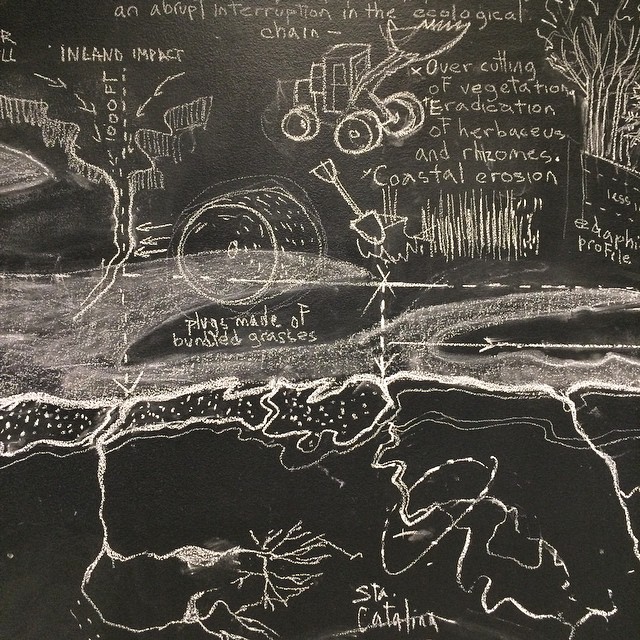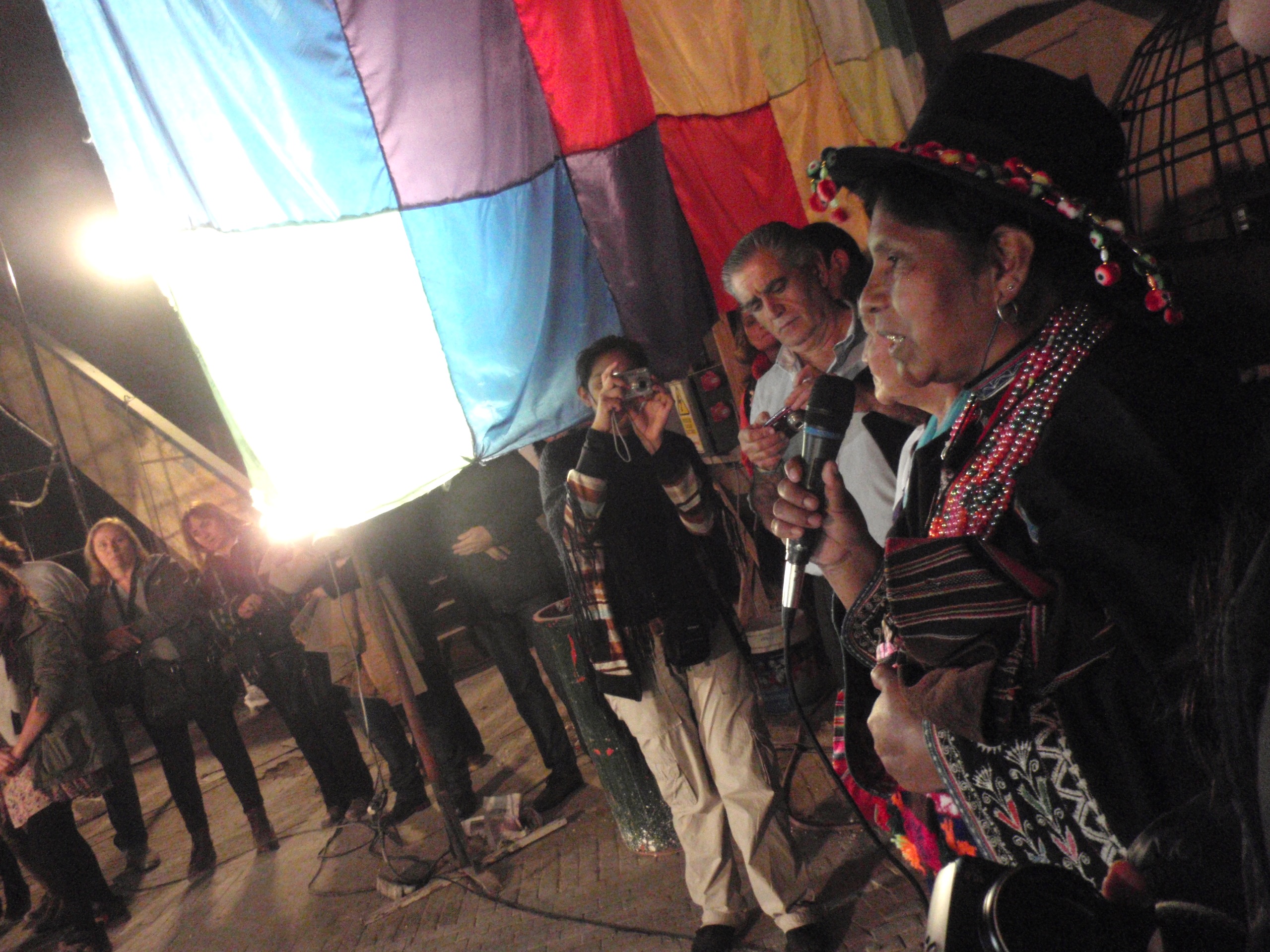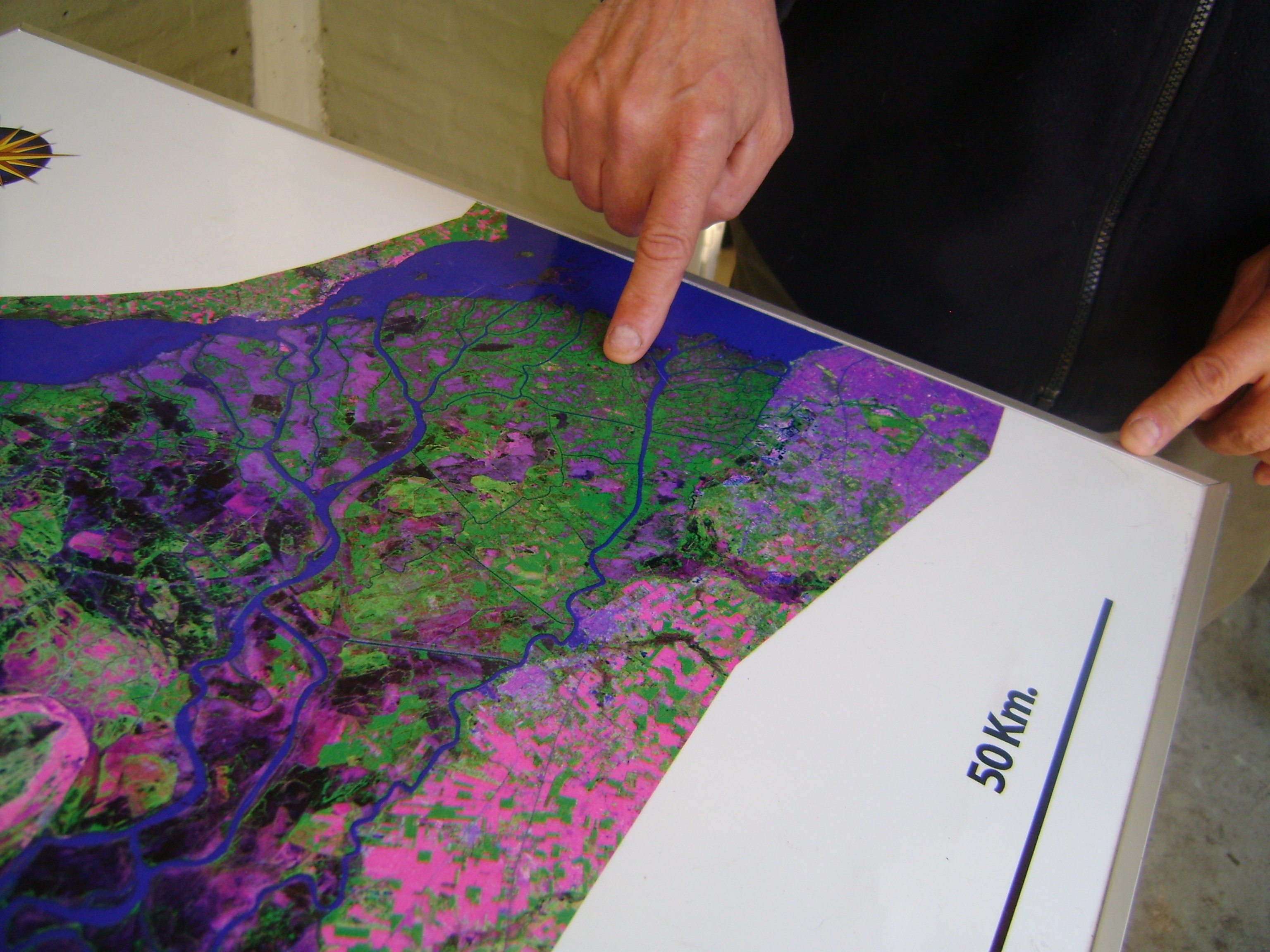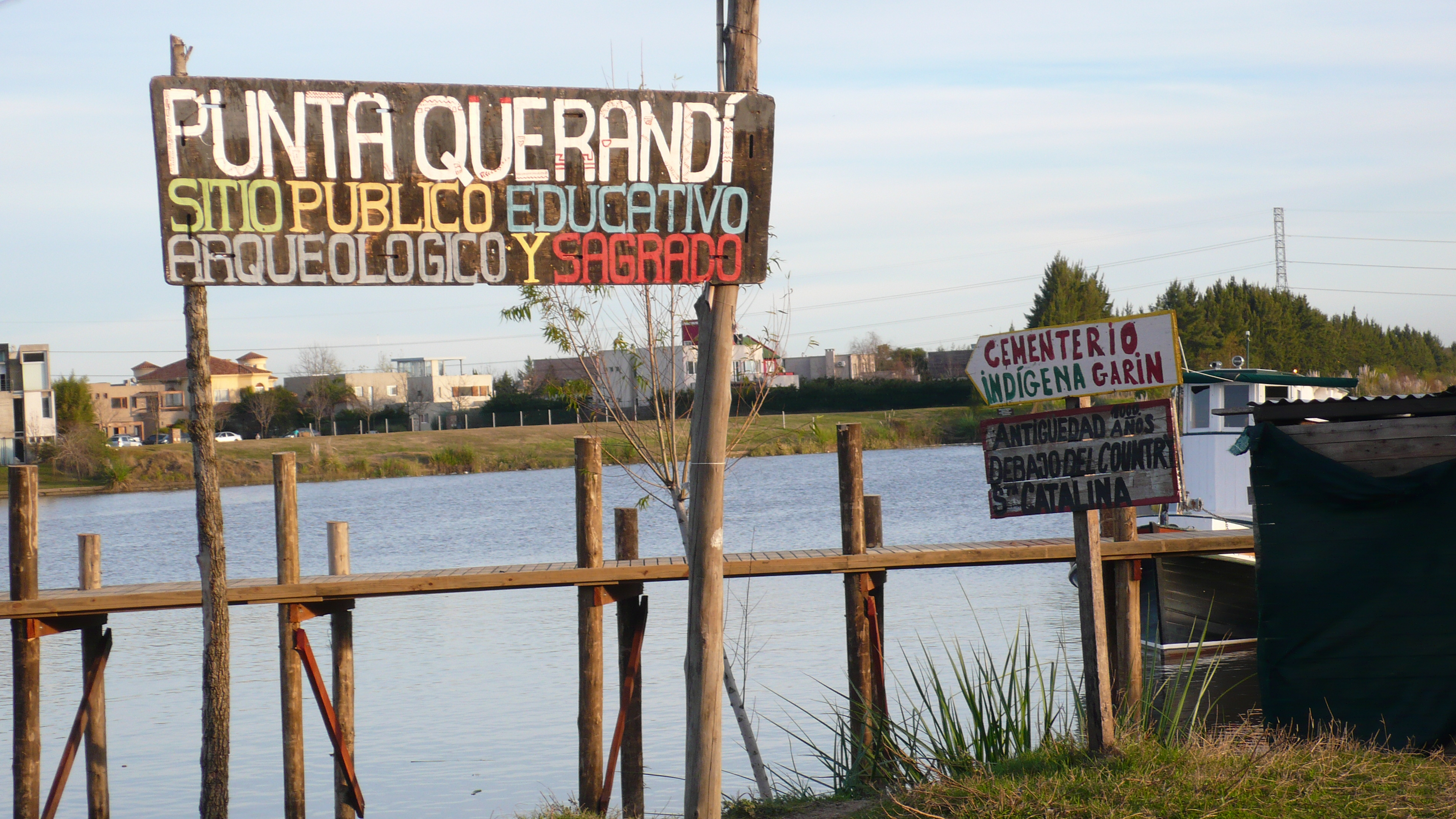“We are so fortunate to be living now because the challenges are so many and we need to use our imaginations in new ways.” Grace Lee Boggs
In June this year, torrential rains at Iguazú led to the closing of tourist sites, and the platform for viewing the waterfalls was all but destroyed. The upper Paraná was said to be carrying 33 times its usual flow and near Ascuncion, and farther west again in Paraguay, at least 300,000 people were flooded out of their homes. This was a month before we flew from Chicago to Buenos Aires, and when our group arrived at Rosario in late July, the still expanding floodwaters were speeding flotsam and freshwater weeds along its swollen surface. Rosario is quite distant from where the Rio Pilcomayo flows into the Paraguay and then joins the Paraná, but people in that city know it takes 25 days for upriver floods to bring the river up along their own shores. The flooding becomes more frequent as land upstream is deforested, mined and paved for roads and cities. Do the people know this too? And I wonder whether the people in St. Louis, near where I live by the Mississippi, know how many days it takes for upstream floodwaters to reach their banks. Those intervals between floods here and floods there might open a window in the skew of time between this place and that, north and south, that illuminates the interdependencies of our fortunes. This meeting is then a question of how to interrogate our temporal and causal connections to locate the time of a river. And to learn how the patterns that emerge from a river and its basin might address the daunting problem of how restorative ecological engagement is so outscaled by global financial ambitions. As Graciela Carnevale points out, there is no more need for growth. How then can humans move toward reinhabiting the basins and rivers as partners, rather than as exploiters?
The Mississippi River, near where I live, is similar to but smaller than the Paraná. Both rivers are wide and shallow, slow and prone to gathering silt. They both wind through slowly descending expanses of grassland where fertility has been built over thousands of cycles of growth, flood, drought, decay and fire. As with the basin through which the Mississippi flows, the land beside the Paraná is compared to Mesopotamia and to global breadbaskets, which means they have the burden of paying the national bills. Their fertile soils have been scorched and scraped by the chemicals and processes of industrialized soy or corn monocultures, which also sicken humans and other living beings. Agricultural by-and breakdown products are washed into gullies and then rivers where they will prove hazardous to more life. The river mouths are pierced with towering steel teeth; infrastructures for processing and moving materials that also leave toxic stains. The problems faced by the Paraná and La Plata basins are familiar ones. Later, back in Illinois, I am invited to give a presentation at a local church. I ask people to describe the rivers near us and someone says, “a river is by definition a roadway.” Together, we survey other ways a river is seen: as a drinking fountain, barricade, border, waste dump, toilet, scenery. This fixation on the river as an economic asset arguably demonstrates what Boaventura de Sousa Santos would call the ‘abyssal thinking’ that society uses to colonize the diverse “ecology of knowledges” which is embedded in place. Given time, perhaps people would start to recall the less visible connections that a river, as a medium, performs to and with numerous species, elements, minerals and the hydrological cycle itself. It is indeed an awesome assembly of agencies, what philosopher Timothy Morton might call a hyperobject. Together, the Paraná, Paraguay and Uruguay rivers drain nearly one quarter of the continent’s surface though the Rio de la Plata estuary into the sea, composing an entity of such spatial and temporal vastness and formal complexity that it exceeds grasp, containment and predictability.
Ala Plastica extends a proposition, asking how basin, or watershed, could become a reference for how other things might flow, perhaps, they suggest, a source of governance, or an experimental platform for how humans could plan, build and imagine. As the basin is already situated within the political sphere; does this mean to defend it more stridently against further depredations by the neoliberal hegemony? Does an experimental platform suggest an eternal state of exception, with permission to try things that may or may not have wider impact? Or is this a call for a turn in overall consciousness? I think yes to all three.
The question floats along with our expedition as we move on and alongside the river’s swells and recesses, and through the thickets and swales of its delta, so that our senses become awakened to its pace. It is a slippery, difficult question that, river-like, assembles and dissolves, gets stuck in a loop or a tidal refrain. We are reordered by the qualities of this watery container, both lubricating and full of frictions, and lose control over time. Does the surrender of time allow for a reordering of values, or does it simply produce anxiety? We also hear many stories and facts, and begin to understand how the basin has been used in the past, and how it is being reorganized at an increasingly aggressive scale and speed for commercial expediencies. These stories and sensations operate as different kinds of information, and extend over the banks into the diverse landscapes and societies that are broadly part of the estuary.
An unwitting handmaiden to politics, a river smoothes access to territories uninvited, where barges are filled with coal, diamonds, rubber, bodies. Yet, like mountains, the riparian environment offers escape, particularly when it flows across political lines. duskin drum cites accounts of how, during the Imperial period in China, marshes and riparian environments provided shelter and hospitality to those who sought to avoid or resist the state’s regulatory grasp; kindred souls such as poets, intellectuals, vagrants, outlaws, itinerant performers and other sorts of dissidents. The needs for retreat or escape ranged, much as the term describing this cultural milieu of the wetlands, “riverslakes,” remains untranslatable. (Wai) According to anthropologist James C. Scott, peoples who rejected civilization could, until recently, depart for the mountains where they would unlearn official languages and abandon literacy. The river/sea is a place of illegibility, and as Santos might suggest, where law is contested, or maybe other laws, of the heart or soul are pursued. So many of the projects we visited defend the vital continuity of lives and cultures for humans and non-humans alike – with water, land, food and health. Throughout the basin, we were welcomed to a soulful resistance in place; in Tigre, the delta, Entre Rios and Isla Paulina. Punta Querandi shimmers for its powerful multi-layered resistance to development. They are preserving physical access to the shoreline for all while also caring for the history of this place over time, ensuring that the present is held responsive to the past and to a future. If the river is anything like a road, access to it should be public.
Another river story from the north: the Mississippi River frequently floods and overflows its banks, despite straightenings, dammings, levees, and locks. It has wiped out cities and forced the relocation of political boundaries. That river is not a road, but a confluence of agencies and riling bodies that periodically repel attempts at control, and increasingly so with global warming induced weather and the continued paving of land. Two hundred years ago an earthquake induced massive internal tsunamis. People say the river ran backwards; watching it rise like a wall before them, they witnessed how it is chained to the earth, like themselves. Alejandro Meitin tells me the animal that most personifies the Paraná is the jaguar, a most dangerous and shape-shifty of forest beings. According to the stories gathered by anthropologist Eduardo Kohn in the Ecuadorian Amazon, the jaguar is dangerous because it is so person-like in its ability to send messages through the dreams of forest-dwelling humans. To think with either governance or laboratory means breaking down a unified sense of the basin to explore what other entities live there, what materials assemble their existence and what languages they speak. There are so many others inhabiting this place than can be known that they might become unpredictable, like the jaguar. Even something simple such as how the water pushes up against its bank is contingent upon another entity or agency, much as Silvina Babich leans into her tango partner, and her partner into her.
One cannot move without finding a new balance. In a small book titled “Figures of Regulation: Guides for Re-Balancing Society with the Biosphere,” bioregional theorist and community organizer Peter Berg sketches out a formal schematic for the reinhabitation of place – what he calls “locating the roots of society in the biosphere.” For the unfamiliar, Berg was a prolific theorist of a movement focused on the watershed as site for collectively reimagining the restoration of ecological fullness and codependency at society’s center. Bioregionalism draws from anarchism, mutualism, biology, and ecology to create a strategic body of practices for resisting the destructive violence of capitalism. The overall goal of inducing cultural habits that ‘root our identity as mammals in the biosphere,’ sounds ambitious, but involves practical steps toward making infrastructures and economies that nestle non-destructively into ‘naturally defined’ ‘life-communities’ that are only limited by the imagination, once that imagination tunes toward place and its own habits. The extraordinary and diverse work and networking of Ala Plastica, La Darsena, El Levante, El Ciclo Ecologico, Red de huerteras y huerteros Rosario and others as makers, thinkers and organizers who bring together and catalyze like-minded folk, is exemplary in this respect.
It is also a project of resubjectivication of the individual and society. Think of Robocop remembering love. Of how Ala Plastica’s reed weaving stores the current in its form. The question is how to nudge toward changes in consciousness, to be saturated by the sense of floating on a river, to let a new perception leak in. Or as Haraway might say, how to ‘stay with the trouble.’ Berg thought of this as a developmental process. “Our social organism is like an embryo that is suffering damage but there are no internal checks on our activities to re-establish a balance with the capacities of natural systems.” In workshops, he urged accountability to place by asking: Who are you? Where are you? What are you going to do about it? This last called for creativity in recognizing, feeling, and actively responding to the need for a balance between people’s needs and the capacity of the ecosystem where they live. In contrast to the outsized growth made possible by fossil fuel extraction and consumption, the watershed represents a scale for living that fosters new infrastructures of material, social and cultural interdependency.
For Berg, a ‘figure of regulation’ was a framework for evaluating and limiting human undertakings, that would be “like customs..[that are] not of a specifically religious, legal or ideological mold.” By attending to the boundaries and limited capacities of a living system, people could begin to visualize interdependency as patterns of exchange that moved around in a cycle, what he called a “cycle of provision.” As a phrase, “figures of regulation” invites different modes of understanding, from the poetic to the practical. The idea of ‘regulation’ references biological or material limits, but also the non-legible or cosmological frames of indigenous jurisprudence, which are cautious about the unknown. Bioregional self-enforcement emerges through trying to attend to the plurality of entities or agencies in a place, to establish a balance point of coexistence. The solar installation at Isla Paulina, the cooperation of urban farmers, the expansion of agroecologial practices and regaining land use decisions in a region are all pragmatic strategies for establishing this balance.
 Ala Plástica – diagram for the exhibition “Citizen Culture”
Ala Plástica – diagram for the exhibition “Citizen Culture”
Figures infer movement itself, such as the individual steps in a dance or in an equation, the lines in a drawing, illustrative steps, the successive removal of material in a sculpture; iterative mark making. “The performance of a dance follows a distinct sense of rightness that would otherwise exist only as an idea, and it suggests connectedness with many other activities and ideas. It is a process that makes the invisible visible. As a dance unfolds it implies further action that is self-referenced by what has gone before. Figures of regulation are assemblages of values and ideas that can similarly become ingrained in patterns of activity.” (Berg) They interrelate and interpolate scale, working between the household/intimate, the social and bioregional in a way that provisions humans and non-humans with food, shelter, energy and transportation, while cycling wastes back in. Bruno Latour calls scale “the result of the number of connections between localities not the circulation through any preordained zoom from the very big to the very small.” Networking the highly local connects yet cherishes diversities. Another kind of figure, the string figure that has captivated Donna Haraway is a demonstration of the way that figuring is a sociable form of representation, translation and exchange.
A week after my comrades from the United States departed, Eduardo Molinari and I attended the unveiling of a statue of Juana Azurduy de Padilla, a 19th century military leader who fought for independence in the lands that became Bolivia and Argentina. We entered an enormous hall with an industrial ceiling hoist reflecting the building’s first life as a Naval school for mechanics. More recently, it was part of the Dirty War’s complex of detention centers but now it is a studio for sculptor Andres Zeneri. Juana Azurduy, cast in bronze, rises nine and a half meters within a tower of scaffolding. The monument is a gift of the Bolivian state and will be placed at the Casa Rosada where a 9-ton homage to Christopher Columbus, a gift from Italy, stood until a year ago. Replacing Columbus with a representation of the half-indigenous Azurduy suggests to me a turn in the national narrative, but Azul Blaseaotto points out that the statue’s upraised fist and forward-leaning stance tropes a line of Western classics that goes back to Victory at Samothrace. Still, there is another narrative; tucked into the tangled, gleaming bronze cape that flows river-like behind Juana, are her four human children along with other beings of the forest and river: jaguar, ciervo and capybara.
The statue’s unveiling coincides with a “birthday” celebration for Pachamama, and a delegation has come from Bolivia to lead a ceremony. A holiday for some; there are at least 100 people, but not a banker’s holiday. We are asked to make a circle and two Bolivian women come around to offer us coca leaves. One wears a black skirt and jacket and brimmed hat ornamented by colorful dangling fringe, the other a knee-length gathered skirt not unlike my mother’s square dance gear. They direct us to hold three leaves up to our neighbor and to attribute to each a sense of time; the left leaf to the past, the right to the future with center in the present. We exchange stories and chew coca. We account for our linear experiences of individual growth and progress- inevitably these move alongside the global expansion of resource frontiers. There is a past time, designated by the presence or lack of colonial violence and appropriation, with much rendered invisible by the self-evidence of the present. Santos’ thoughts on time are compelling and difficult because there are two times; that of the ‘metropolitans’ and the colonized. The future is truncated and decimated as a possibility by the manipulations that destroy all evidence of the minor, the undercurrents, and the invisible of the past and the present. I feel that we are being asked to compel a different future into being.
> Birthday celebration (Photo: Eduardo Molinari)
Birthday celebration (Photo: Eduardo Molinari)
A band enters playing flutes, drums and charangos and we are told to hold hands and run or dance around the gigantic figure of Juana Azurduy for a very prolonged period. It feels like being in a flood for it is not under control, or a child’s game going on overlong, or a ritual. The music loops with no beginnings or endings and we trip over stones, rigging, light cables on the ground, all the while holding hands. Rodolfo Kusch, who wrote about Américan forms of consciousness that were displaced by colonialism, says that ritual is a way of thinking and of expanding knowledge. Reflecting on the repetitive nature of our ‘dancing’ around the monument, I wonder what kind of knowledges. Our figuring assembly teases opens a non-Euclidean shapeliness as the moving mass (I hesitate to identify a subject) loses inhibition, grace, coordination and gains maybe, different senses of space and time, and this is not necessarily comfortable. Later I read that ‘pacha’ is expressed both as temporality and in place, the here and now of life, changing contextually through the daily, monthly, annually, rhythmic work of planting, weaving, channeling, sifting, moving silt, moving goods, remembering patterns and alliances between entities. Movement pushes away derivative and the divisional tendencies as we loop through the same space, the same but cognitively changed each time, and resistance is forged through reproduction and diversification. It is common law for rivers and basins. Because the future reveals no more frontiers, it is time to create a permeable frontier of affect, with new languages and senses.
Sarah Lewison
.
.
Thanks to Eduardo Molinari, Brian Holmes and duskin drum – and to Ala Plástica and Critical Art Ensemble for inviting me along.
.
References
Berg, Peter. Figures of Regulation: Guides for Re-Balancing Society with The Biosphere. San Francisco: Planet Drum Foundation. 1982.
Drum, Duskin. Daoist Rhetoric and Movement. 2013.03.15. Unpublished manuscript.
Haraway, Donna. “Multispecies Cosmopolitics: Staying with the Trouble” 2013 Institute for Humanities Research Distinguished Lecture. Arizona State University. March 5, 2013. https://vimeo.com/62081248
Kohn, Eduardo. “How Forests Think. Toward an Anthropology beyond the Human.” Oakland: University of California Press. 2013.
Kusch, Rodolfo. “Indigenous and Popular Thinking in América.” Trans. Maria Lugones and Joshua Price. Durham:Duke University Press, 2010.
Latour, Bruno. “The Anthropocene and the destruction of the image of the Globe.” The Gifford Lectures on Natural Religion Edinburgh: March 1, 2013. https://www.youtube.com/watch?v=4-l6FQN4P1c&index=12&list=PLEA9467E8E8D991AE
Morton, Timothy. “Hyperobjects: Philosophy and Ecology after the End of the World” Minneapolis and London: University of Minnesota Press. 2013.
Santos, Boaventura de Sousa. “Beyond Abyssal Thinking: From Global Lines to Ecologies of Knowledge” Review, XXX-1-2007.
Scott, James C. “The Art of Not being Governed: an anarchist history of upland Southeast Asia.” New Haven: Yale University Press. 2009.
Wai, Wu Helena Yuen. “A Journey across Rivers and Lakes: A Look at the Untranslatable Jianghu in Chinese Culture and Literature.” 452oF: Revista de Teoría de La Literatura Y Literatura Comparada, no. 7 (2012): 58–71.

